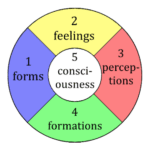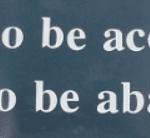
Ngöndro, ‘Go Before,’ the Tibetan Buddhist preparatory practices for entering Vajrayana, consists of prostrations (Refuge) & Bodhicitta, Vajrasattva Mantra (Purification), Mandala of Great Offering (generosity), and Guru Yoga of union with the wisdom mind of all Gurus. Each practice typically consists of 100,000 repetitions.
Table of Contents
Explanation of ngöndro
The point of ngöndro is to prepare the mind by deepening commitment, purifying obscurations, developing virtue, and opening to the deeper reality of the mind. The practices are meant to prepare the student to enter the Vajra world through the empowerment or abhisheka presented by the lama. After the student is empowered to practice the sadhana of the deity.
Outer Preliminaries
Ngöndro has its own sort of ngöndro, or that which ‘goes before,’ in the form of the four reminders, contemplations which turn the mind to the dharma. These are
- The precious human birth – emphasizes one’s fortune in finding the dharma, and having the opportunity to hear, understand, and practice it compared to all other samsaric states. The idea – take advantage of your good fortune and practice.
- Impermanence and the certainty of death – This opportunity is fleeting, so do not delay or be sidetracked. Practice now. Develop urgency.
- The shortcomings of samsara – Samsara is an endless cycle, which will never break on its own. We are propelled from life to life, and some of those lives will entail immense suffering. All will include some level of suffering. This establishes the goal of exiting samsara.
- The inevitability of karma – Karma is the only thing that travels from life to life with the mind. We continually accumulate karma, so we need to find a means to overcome it and halt the flow. That path is the dharmic path of the Buddha.
Four reminders practice, the outer preliminaries, is typically included in every session of ngöndro. It is intended to establish a sense of the goal, the import, and the urgency of practice. It also is practiced independently and in other contexts.
Inner Preliminaries
The ancient times’ students, most notably Milarepa, but others as well, went through an unofficial, uncodified ngöndro, an extreme trial by fire at the personal hand of their lamas. These ordeals purified and ripened the mindstreams so the students could properly experience the meaning of the teachings, see the nature of their mind, and overcome their obscurations through deepening meditation.
Prostrations
First is prostrations, or taking of refuge and generating the bodhicitta through the bodhisattva vow and tonglen (sending and taking) practice. These are typically combined as one so that there are 4 special or inner preliminary practices. I will treat them separately for ease of understanding. The majority of the time is spent on prostrations, then 20% or so spent on tonglen.

Prostrations involve visualizing the Refuge Tree, with the guru and various forms of the Sambhogakaya deities. Vajradhara (your own guru in that form) is at the center of the tree shown here. At the top is Samantabadhra, the primordial buddha, and beneath are the lineage forefathers from Tilopa to Karma Pakshi, with all the Karmapas surrounding.
Buddha Shakyamuni is at the bottom right, with Yidams straight below and the protectors arranged in front. Practitioners are prostrating to develop stronger faith so that they can properly enter the mandala. You perform 100,000 prostrations toward the mandala. This takes anywhere from 2 months to 1 year normally.
At this point, you are in an ordinary form as yourself, prostrating to an image of idealized wisdom. To perform a prostration, the hands are placed palms together (anjali) and touched to the crown or the forehead, then to the throat, then to the heart. These are the three Centers or Gates. Head symbolizes the body, throat – the speech, and heart – the mind, so this 3-fold touching indicates taking refuge fully with the entirety of one’s being, taking refuge fully and completely. Then you drop to hands and knees, sliding forward on the hands until completely prone. After, you arise and repeat.
By doing 100,000 prostrations, immense merit is generated, the directed fuel that pushes you toward enlightenment. This is taking refuge in a tantric way. The extremeness of this changes the feeling of being Buddhist as a part of one’s identity to being Buddhist as the primary focus of one’s identity. Taking refuge in this way can help you find the dharma in future lives. Prostrations also purify the body of karmic obscurations to enlightenment. It is especially helpful to purify pride and arrogance.
The typical formulation is as follows with Yidam and Dharmapala not always included, but understood as aspects of the Guru.
I take refuge in the Guru
Refuge Vow
(I take refuge in the Yidam
I take refuge in the Dharmapala)
I take refuge in the Buddha
I take refuge in the Dharma
I take refuge in the Sangha
After a session of prostrations, the practitioner performs a Mahayana liturgy – the four immeasurables typically – then bodhicitta practice. Tonglen – sending and receiving – is the most common. In Tonglen, the meditator visualizes taking in the pain and suffering of another, then all beings, purifying it in emptiness and sending out beneficial light to soothe the suffering.
This meditation turns the mind toward the benefit of others, creating the proper attitude for enlightenment. At this point, we’re still doing hinayana and Mahayana practice essentially.
Vajrasattva Mantra

The next practice is called Vajrasattva mantra. Though not an official View, the next 3 ngöndros bear some correspondence to the outer 3 yanas – kriya, upa, and yoga yana. Kriya relates to purification, conduct, and cleanliness. Vajrasattva is the epitome of purification. He also carries other methods and meanings and is one of the most central deities in the Tibetan system altogether. A sort of coalescent principle, Vajrasattva is compared to white light passing through a prism to become the rainbow or all the other deities.
In Vajrasattva practice, which is a sitting meditation like mandala and guru yoga, we purify the general sense of karma with an especial focus on speech. Vajrasattva purifies both dikpa and drippa. Dikpa is the emotional and action obscurations – negative actions and the tendency to negative emotions. Drippa is the more subtle level – the tendency toward such actions and the underlying cognitive obscurations such as the assumption of duality.
One visualizes the deity on top of the head, purifying the body through a visualized ritual purification. Details vary and should be received from one’s own tradition or lama. At the same time, the hundred-syllable mantra of Vajrasattva is repeated 100,000 times. This takes quite a bit of time and many people get stuck here even if they complete prostration. Almost everybody who completes these 2 will finish ngöndro.
After a session of Vajrasattva, the body should feel light and pure. The karma has been purified. The practitioner visualizes that their karma has been fully purified and Vajrasattva dissolves into them.

Flow, the profound mental state, also called Peak Performance, can be attained with meditation and can be ‘triggered’ at will, with enough discipline. Guide to Flow Mastery will teach you how.
Mandala Offering
Next is the mandala offering. I correlate this to upa or charya tantra, which emphasizes a balance of conduct and inner meditation. The mandala offering is performed with a basket filled with saffron rice with precious stones and objects added. These should denote value to the practitioner. A mandala plate is in the basket with another placed on the shrine. The shrine plate signifies the enlightened mandala with the central deity surrounded by the retinue. This symbolizes the limitless wealth of enlightened mind and qualities.
The practitioner’s basket of rice and the plate symbolizes the ordinary wealth of phenomena. They surrender everything they have to the enlightened mandala. The point is to generate dana, generosity. By offering everything to the deity, it is not that you lose everything, that it all goes away. It’s more that it becomes enlightened manifestation. You’ve given it to the Buddhas and enlightened beings. They will then inhabit those things. Then all the phenomena of your life become alive and enlightened with their energy. You no longer ‘own’ those things.
Generosity is the virtue that produces peace
Zen Meal Chant
They are there in an empty way, belonging to the Buddhas and deities, so they can live in them and shine wisdom from them. It’s a means of having enlightened energy inhabit your life in a profound and powerful manner. Everything you own, are, and perceive becomes imbued with wisdom. It all has ‘buddha’ in it, the enlightened energy of Vajrasattva, the guru, the wisdom mind. Buddha nature is seen to suffuse everything.
Generosity links to the 6 paramitas, being the first of them. Generosity has three types: giving of material possessions to help people and make them happy (lowest form), fearlessness in the face of samsara and difficult circumstances (intermediate form), and dharma to guide them out of samsara (higher form of generosity). Transcendent generosity is non-attachment. Extensive explainer of generosity here.
One creates a mandala by heaping several small piles of rice onto the mandala plate and ‘offering’ it to the deity. It symbolizes the totality of one’s life. After being swept off, the piles are repeated. 100,000 of these are performed with an accompanying chant indicating that the entire earth, the universe, and all phenomena are offered to the deity to purify.
Guru Yoga

Lastly is the guru yoga. One yogi always ducked his head when he entered a building. Asked why, he responded, “Because the guru is on my head.” Yoga means union, so this means uniting with the mind of the guru. Being on the head signifies the descending of blessings. I equate this with the yoga tantra because it focuses on the inner qualities of meditation on reality and skillful means – jnana and upaya.
The four ngöndros are done sequentially, meaning that one does not do the later ones until completing the earlier. When doing mantra, one does a few prostrations and bodhicitta, then the bulk of the session is mantra, then close without mandala or guru yoga. You do all 4 practices when doing guru yoga, but not before.
In guru yoga, the meditation is to sit and visualize the guru in a light-based form on top of the head. Blessings then suffuse your existence. All your family, friends, enemies, and everything you perceive become suffused with unadulterated pure wisdom. In a sense, this is the culmination of mandala as discussed above. In mandala practice, the deities are offered your existence. Here they truly inhabit it in the form of wisdom blessings. Anything can be seen as a manifestation of wisdom. This is the union of the mind and ‘guru.’
Adhisthana is blessings from the guru.
It’s easy to fall into the common trap of thinking you are uniting your mind with the physical, human guru. That’s a lesser view. The point is to overcome the dualistic barrier altogether. When you think of your teacher, he or she has a vast mind that is not constrained by duality. The physical form you see is but a tiny part of the guru’s wisdom mind. This mind is also your mind already, but guru yoga provides an upaya, or skillful means, to open to that reality in meditation.
Importantly, you are not lesser, inferior, or bad in any way here. You are just somewhat confused about the nature of reality, so the guru is helping you clear that up and claim your birthright, the same as all the buddhas. You are a buddha, but you don’t quite perceive that or the meaning of it. Meditation is necessary to slowly overcome the confusion.
4 Gurus
- Human guru
- Guru of phenomena
- Guru of transmuted emotion
- Absolute Guru of Awareness
There are said to be 4 gurus. The human guru – you want to mingle your mind with them because they have the vast mind that will free you. The guru of phenomena – all appearances become teachings, imbued with the empty buddha essence. They wake you up, allowing you to dissolve into the ultimate mind. The guru of ‘purified emotions’ or the activities of mind. When these negative emotions are purified, they are seen to be, in reality, the enlightened mandala of the primordial buddhas.
the 4th is the guru of pure awareness – the absolute nature of buddha – buddhaness itself. Your own deepest being is therefore the ultimate guru. This is finally what you seek union with. It is essential, however, to include the other 3, and especially your human guru. This precludes arrogance and maintains devotion. Even the greatest teachers remain students.
In this sense, we overcome the boundaries of mind. So having the human guru manifest in the form of light slowly brings out these other, increasingly profound layers of guru until your mind is uniting more directly with reality itself.
There are details in the various ngöndros that should be found by receiving the transmission for that practice. It would be inappropriate to discuss them beyond this general presentation.
FAQS
What is the ngöndro practice in Buddhism?
The ngöndro practice in Buddhism prepares the student for the higher tantric practices. ngöndro generates strong devotion, purification of karma, generosity/surrender, and union with the mind of enlightenment.
What is the purpose of ngöndro?
The purpose of ngöndro is to prepare the student for abhisheka and advanced practice. ngöndro purifies the mind and unites it with the guru.
How long does it take to do ngöndro?
Ngöndro takes as little as 6 months for a young and diligent practitioner, like a monk in his teens. Westerners are older, with busier schedules, and generally take 2 years if dedicated or much longer if less so.
What is the introduction of ngondro?
The introduction of ngöndro can refer to the idea of preliminary practice, that which ‘goes before’ – the literal translation. Ngöndro goes before advanced Vajrayana practice.
What are the four thoughts of ngöndro?
The four thoughts of ngöndro are the common preliminaries or 4 thoughts that turn the mind to the dharma:
Precious human birth
Impermanence and death
Inevitability and trap of karma
Shortcomings of samsara, the wheel of conditioned existence
Is ngöndro necessary?
Generally, ngöndro is necessary for engaging in higher yana practices such as Vajrayogini or the four yogas of Naropa.
What is the origin of ngöndro?
The origin of ngöndro is unclear, though one theory ascribes it to Marpa’s purification of Milarapa before he gave him Vajrayana teachings. However, this was not a codified ngöndro.
Summary
Ngöndro is a preparatory set of meditation practices. The main components are Prostrations (refuge) and bodhicitta, Vajrasattva mantra (purification), mandala offering (generosity), and guru yoga (union with wisdom). These are intended to purify and ripen the students so they can receive the teachings properly, so they make sense in a detailed manner, and so the higher practices can be accomplished. This way they can see the truth of their mind essence and bring forth genuine powerful compassion and genuine wisdom when they do the profound Vajrayana practices of the inner yogas.

May all beings be happy
May all beings be peaceful
May all beings be safe
May all beings awaken to the light of their true nature
May all beings be free







